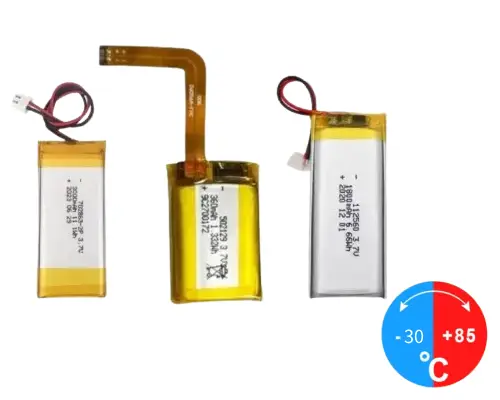Wide-temperature lithium-ion battery

Wide-temperature lithium-ion batteries are specially designed with advanced processes and materials, enabling reliable charge and discharge performance in extreme conditions such as –40℃ low temperature, 85℃ high temperature, or a wide range from –30℃ to 85℃. Compared with conventional batteries, they deliver exceptional performance under harsh environments, making them the ideal choice for aerospace, military, industrial equipment, outdoor electronics, and other demanding applications.
FAQs
High-temperature lithium-ion batteries can operate at what maximum temperature?
High-temperature lithium-ion batteries can usually operate stably in environments of +60℃ to +75℃, and some specially formulated batteries can withstand temperatures above +80℃.
Why are high-temperature batteries less prone to swelling or thermal runaway?
These batteries typically use high-temperature resistant separators, heat-resistant cathode materials, and high-temperature electrolytes, which reduce the rate of high-temperature side reactions. Coupled with protection circuits, they effectively prevent thermal runaway and swelling.
Why does battery capacity decrease in cold environments?
At low temperatures, lithium-ion mobility slows and internal resistance increases, reducing discharge capacity. Optimizing electrolytes and electrode materials can help mitigate capacity loss.
Does temperature affect the cycle life of high-temperature batteries?
High temperatures accelerate chemical side reactions, slightly shortening the battery’s lifespan.
Are there special charging requirements for low-temperature batteries?
At low temperatures, lithium-ion activity decreases, and direct charging may damage the battery. It is recommended to use chargers with low-temperature protection or preheat the battery before charging.
Can high-temperature or low-temperature batteries be customized for different environments?
Yes. Irayenergy can customize cell materials, electrolytes, and protection boards according to customer environments to provide specialized high-temperature or low-temperature battery solutions.
What are the characteristics of lithium-ion batteries at –40℃?
In low temperatures, battery capacity drops significantly, lithium-ion mobility slows, and internal resistance increases, greatly reducing current output and capacity. At extremely low temperatures, the battery may fail to start devices, especially under high discharge demand.
If a lithium battery’s capacity drops around –20℃ in winter, will it recover when the temperature rises?
Capacity loss due to short-term low temperatures can recover when the battery warms up. However, prolonged low-temperature storage or over-discharge can affect overall battery performance.
Why is damage caused by low temperatures to lithium batteries irreversible?
Main reasons include:
1) High-rate charge/discharge at low temperatures can generate lithium dendrites, piercing the separator and causing permanent damage;
2) Electrode structure can be damaged, leading to active material loss and permanent capacity decline;
3) Electrolyte side reactions may occur locally, increasing internal resistance. Prolonged low temperatures or improper operation negatively affect performance and lifespan.




